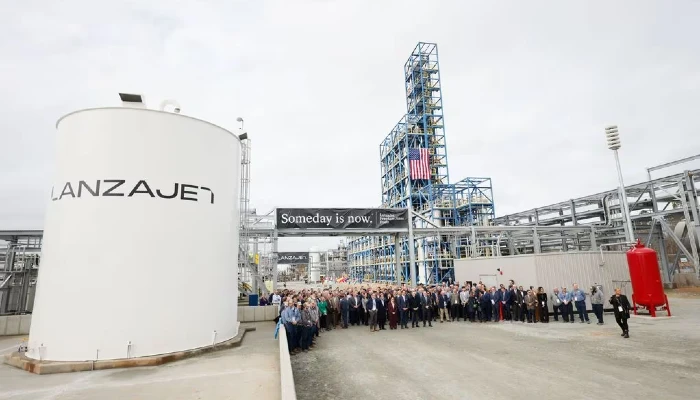In the fight against climate change, the aviation industry stands as a formidable challenge. While some sectors have stabilized their greenhouse gas emissions, aviation continues to soar as a significant contributor.
Traditional jet fuels, extracted from the depths of the earth, have long powered our flights, but at a considerable environmental cost. However, a groundbreaking development in rural southeast Georgia is poised to change this narrative.
A New Dawn for Aviation: The LanzaJet Revolution
In the verdant landscapes of Soperton, Georgia, a remarkable transformation is underway. Here, LanzaJet, an Illinois-based fuel technology company, has unveiled its pioneering sustainable aviation fuel (SAF) production facility.
This plant, strategically situated off Interstate 16, is the first of its kind globally, capable of converting ethanol into SAF. It’s not just a factory; it’s a beacon of hope for a greener future.
The aviation sector, responsible for about 2% of global greenhouse gas emissions and 12% of transportation emissions, finds itself at a crossroads.
Electric aircraft and other innovative technologies are on the rise, but SAFs have captured the imagination of major airlines, investors, and even the federal government.
These fuels, derived from sustainable sources like corn, food and yard waste, woody biomass, and used cooking oils, promise a significant reduction in emissions compared to their fossil fuel counterparts.
At the heart of LanzaJet’s facility, ethanol from diverse feedstocks will undergo a transformative chemical process. This maze of tanks and pipes will produce a more energy-dense fuel, essential for powering aircraft.
According to CEO Jimmy Samartzis, LanzaJet’s fuel, while still combustible in engines, boasts a 70% reduction in greenhouse gas emissions compared to conventional jet fuel.
In his grand opening address that included politicians, executives and David Turk (U.S. Department of Energy Deputy Secretary), Samartzis emphasized the immediate impact of these fuels in bending the carbon curve and advancing towards net-zero and carbon-negative fuels in the future.

A Small Start with Big Ambitions
LanzaJet’s Freedom Pines Fuels Plant, despite its groundbreaking technology, will initially contribute a modest 10 million gallons of SAF and renewable diesel yearly. This figure pales in comparison to the 10 to 19 billion gallons consumed by U.S. airlines annually. Yet, this is a significant first step in a longer journey towards sustainability.
The U.S. government, under President Joe Biden’s leadership, has ambitious goals for SAF production. By 2030, at least 3 billion gallons of SAFs are targeted for production, aiming to meet 100% of U.S. aviation fuel demand by 2050.
More To Discover
- Silkworms Challenge Nylon and Kevlar in Environmental Showdown: Genetically Enhanced Caterpillar Set to Revolutionize Green Fabric Production
- Lab-Grown Oil: The Next Frontier in Sustainable Food Production?
- How New Tax Rules Will Make It Cheaper To Go Green And Connect To The Grid
- Sustainable or Not? The Controversy Over Gear Used in MSC-Certified Tuna Fishing

Fueling the Future: Incentives and Innovations
The Inflation Reduction Act, a landmark climate and healthcare law signed by President Biden, plays a pivotal role in making SAFs competitive. It offers a $1.25 per gallon tax credit for SAF producers whose fuels have at least 50% lower lifecycle greenhouse gas emissions than traditional jet fuels. This incentive can increase to a maximum of $1.75 per gallon, encouraging higher emission reductions.
LanzaJet is poised to begin start-up operations soon, with 10-year sales agreements already in place for its entire fuel production. The facility is expected to create 250 jobs, marking a significant economic impact.
Meanwhile, other SAF production technologies are emerging, including one in Georgia that converts wood chips into jet fuel (one in the UK is using human waste). As the industry watches closely, the question remains: Will LanzaJet’s fuels be the solution the aviation industry needs for a more climate-friendly future? Only time will tell, but the journey towards a greener sky has undoubtedly begun.



















